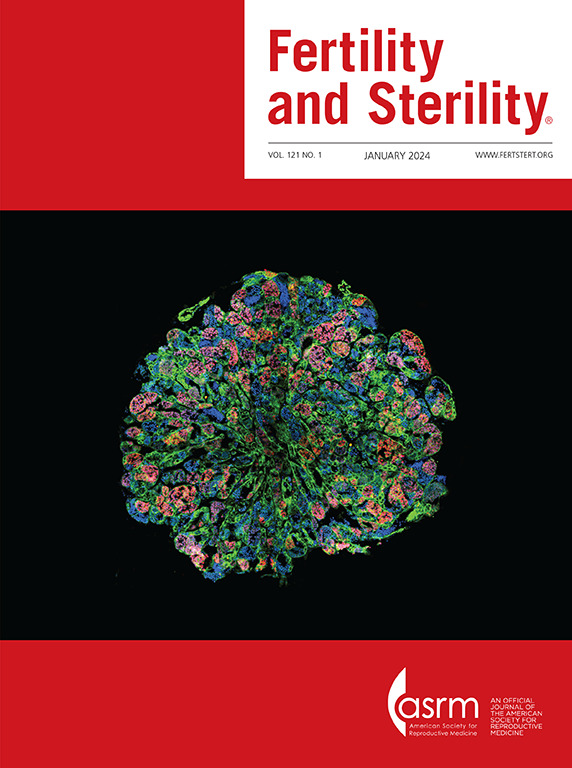Embryofetoscopy followed by hysteroscopic evacuation of a first trimester missed abortion in a woman with septate uterus
IF 6.6
1区 医学
Q1 OBSTETRICS & GYNECOLOGY
引用次数: 0
Abstract
Objective
To describe the technique of embryofetoscopy performed with 5Fr instruments with targeted evacuation of the gestational sac followed by a visual dilatation and curettage (D&C) using the hysteroscopic tissue removal system for the management of first trimester missed abortion in a patient with uterine septum.
Design
Video case-report.
Subjects
A 32-year-old nulliparous (G3P0020) woman with septate uterus and a 7-week missed abortion. Written informed consent was obtained from the patient.
Exposure
Transvaginal pelvic ultrasound revealed a 7-week missed abortion. A 3D-ultrasound confirmed the presence of a partial uterine septum. Operative hysteroscopy under spinal anesthesia was performed using a vaginoscopic approach. A partial septum was observed, and a dysmorphic gestational sac was visualized in the left hemicavity.A small incision was made in the amniotic sac using a 5Fr-bipolar electrode allowing direct visualization of the embryo. The entire embryo was removed, and selective biopsies of the chorionic villi using the hysteroscopic “grasp biopsy” technique were obtained. The residual gestational sac was removed using a 6.25 mm tissue retrieval system. No cervical dilation was required.The patient was discharged on the same day of the procedure. No intraoperative bleeding was encountered. The overall operation time was 21 minutes. A postprocedure ultrasound confirmed the presence of an empty cavity. It was determined that further evaluation of the septum was needed before proceeding with hysteroscopic metroplasty.
Main Outcome Measure(s)
Step-by-step demonstration of the technique and some tips and tricks for bleeding management.
Result(s)
Complete evacuation of the uterine cavity under direct visualization.
Conclusion(s)
Embryofetoscopy with miniaturized instruments allows selective targeting of trophoblastic and fetal tissues, avoiding the risk of maternal tissue contamination of the specimen. As reported in the literature, the visual D&C using tissue retrieval system could be a safe and innovative alternative for the treatment of early pregnancy loss. Compared with the use of hysteroscopic resection, tissue removal devices offer the advantage of not requiring cervical dilation and do not involve the use of electrosurgery, thus reducing damage to the uterine cavity. The combination of embryofetoscopy with visual D&C offers several advantages, especially in patients with congenital uterine anomalies, in which performing a blind D&C has a higher risk of complications.
Embrioscopia fetal seguida de evacuación por histeroscópica de un aborto retenido en el primer trimestre en una mujer con útero septado.
Objetivo
Describir la técnica de embrioscopia fetal realizada con instrumentos 5Fr con evacuación dirigida del saco gestacional seguida por una dilatación visual y curetaje (D&C) utilizando un sistema de extracción de tejido histeroscópico para el manejo del aborto retenido en el primer trimestre en una paciente con septo uterino.
Diseño
Informe de un caso en video.
Lugar
Hospital universitario de atención terciaria.
Paciente(s)
Mujer nulípara de 32 años (G3P0020) con útero septado y un aborto retenido de la semana 7. Se obtuvo el consentimiento informado por escrito de la paciente.
Intervención(es)
Una ecografía pélvica transvaginal reveló un aborto retenido de la semana 7. Una ecografía 3D confirmó la presencia de un septo uterino parcial. Se realizó una histerectomía bajo anestesia espinal utilizando un abordaje vaginoscópico. Se observó un septo parcial y un saco gestacional dismórfico en la hemicavidad izquierda. Se realizó una pequeña incisión en el saco amniótico utilizando un electrodo bipolar de 5Fr, permitiendo la visualización directa del embrión. Se extrajo todo el embrión y se obtuvieron biopsias selectivas de las vellosidades coriónicas utilizando la técnica de “biopsia por pinza” histeroscópica. El saco gestacional residual se eliminó con un sistema de extracción de tejido de 6.25 mm. No se requirió dilatación cervical. La paciente fue dada de alta el mismo día del procedimiento. No se encontró sangrado intraoperatorio. El tiempo total de la operación fue de 21 minutos. Una ecografía posterior al procedimiento confirmó la presencia de una cavidad vacía. Se determinó que era necesario evaluar más el septo antes de proceder con una metroplastia histeroscópica.
Medida(s) de resultado principal(es)
Demostración paso a paso de la técnica y algunos consejos y trucos para el manejo del sangrado.
Resultado(s)
Evacuación completa de la cavidad uterina bajo visualización directa.
Conclusión(es)
La embrioscopia fetal con instrumentos miniaturizados permite la extracción selectiva de tejidos trofoblásticos y fetales, evitando el riesgo de contaminación del espécimen con tejido materno. Como se ha informado en la literatura, el D&C visual utilizando un sistema de extracción de tejidos podría ser una alternativa segura e innovadora para el tratamiento de la pérdida temprana del embarazo. En comparación con el uso de resección histeroscópica, los dispositivos de extracción de tejidos ofrecen la ventaja de no requerir dilatación cervical y no implican el uso de electrocirugía, reduciendo así el daño a la cavidad uterina. La combinación de embrioscopia fetal con D&C visual ofrece varias ventajas, especialmente en pacientes con anomalías uterinas congénitas, en las que realizar un D&C a ciegas conlleva un mayor riesgo de complicaciones.
对一名子宫中隔的妇女进行胚胎镜检查,然后在宫腔镜下进行清宫术,以解决一胎流产失手的问题。
目的:探讨采用5Fr器械行胚胎镜术,在宫腔镜组织切除系统下,有针对性地取出妊娠囊,目视扩张刮除术(D&C)治疗子宫间隔早孕期漏产的方法。设计:视频病例报告。患者:32岁无产(G3P0020)女性,子宫间隔,7周未流产。干预措施:经阴道盆腔超声检查发现7周未堕胎。3d超音波证实存在部分子宫间隔。脊柱麻醉下经阴道镜行手术宫腔镜检查。可见部分鼻中隔,左侧腔内可见畸形妊娠囊。使用5fr双极电极在羊膜囊上做一个小切口,可以直接看到胚胎。整个胚胎被切除,使用宫腔镜“抓活检”技术对绒毛膜绒毛进行选择性活检。使用6.25 mm的组织回收系统去除残留的妊娠囊。不需要宫颈扩张。病人在手术当天出院。术中无出血。手术总时间21分钟。术后超声检查证实了空腔的存在。我们确定在宫腔镜下进行子宫成形术前需要进一步评估隔膜。主要观察指标:分步演示技术及出血处理的一些技巧。结果:在直接观察下完全清除子宫腔。结论:使用小型仪器的胚胎镜检查可以选择性地靶向滋养细胞和胎儿组织,避免了母体组织污染标本的风险。据文献报道,使用组织检索系统的视觉D&C可能是治疗早期妊娠丢失的一种安全而创新的替代方法。与宫腔镜切除相比,组织切除装置的优点是不需要宫颈扩张,也不涉及使用电手术,从而减少了对子宫腔的损伤。胚胎镜与目视D&C相结合有几个优点,特别是在先天性子宫异常患者中,进行盲D&C有更高的并发症风险。
本文章由计算机程序翻译,如有差异,请以英文原文为准。
求助全文
约1分钟内获得全文
求助全文
来源期刊

Fertility and sterility
医学-妇产科学
CiteScore
11.30
自引率
6.00%
发文量
1446
审稿时长
31 days
期刊介绍:
Fertility and Sterility® is an international journal for obstetricians, gynecologists, reproductive endocrinologists, urologists, basic scientists and others who treat and investigate problems of infertility and human reproductive disorders. The journal publishes juried original scientific articles in clinical and laboratory research relevant to reproductive endocrinology, urology, andrology, physiology, immunology, genetics, contraception, and menopause. Fertility and Sterility® encourages and supports meaningful basic and clinical research, and facilitates and promotes excellence in professional education, in the field of reproductive medicine.
 求助内容:
求助内容: 应助结果提醒方式:
应助结果提醒方式:


